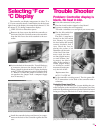
9
Lost Wax
Burnout
CAUTION: Only kilns with vent holes are designed
forlost waxburnout. However,you maybe abletouse a
kiln without the vent hole provided that you open the
door ½” during venting.
CAUTION: Always use a wax tray.
Note: These instructions apply to injection wax that
melts at 200°F, not pattern waxes and plastics that
melt at higher temperatures. If smoke appears during
wax elimination, turnoff the kiln.Smoking wax means
the kiln fired hotter than 300° / 148°C.
Overview
Lost wax casting is the process of carving a shape in wax,
making a mold, and then casting that shape in metal. After
the wax has been carved, a mold is made of the wax shape.
The mold is a negative image of the wax. The wax is later
melted out of the mold through hollow channels called
sprues.
Lost wax burnout is the process of preparing a casting
mold for the melted metal that will be poured into it. The
steps in lost wax burnout:
Melt the wax from the mold.
Remove wax from the kiln before raising the tem-
perature higher than 300°F/148°C.
Harden the mold at high temperature.
Maintain the mold at the casting temperature rec
-
ommended for the type of metal that will be poured
into the mold.
CAUTION: Prevent wax or carbon from contacting
the kiln’swalls andelements. Carbonbuild-upinside a
kiln ruins the interior. Carbon conducts electricity and
causes elements to short circuit. Damage to elements
from contact with foreign materials is not covered by
warranty.
A Sample Program
See instructions on page 8 to enter this program:
Rate Temp.
Segment °F/°C °F/°C Hold
1 500/277 300/148 01.00
2 500/277 1350/732 01.00
3 450/250 800/426 02.00
Segment 1heats the waxto 300°F /148°C and holds itfor
one hour, allowing it to drip from the mold.
Segment 2 hardens the mold.
Editing the Target
Temperature
While the kiln is firing, you can change the target tem
-
perature of the current segment. (Ramp-Hold: You can
edit only the segment that is firing. So if the first segment is
the current one, you can edit only the first segment. Toedit
other segments,wait untilthe firinghas progressedto those
segments.)
Even if the current segment has already started its hold
time, you can still edit the segment's target temperature.
The controller will go back out of hold and fire to the new
target temperature at the original rate. (You cannot edit
the rate, however.)
During a firing, press the repeatedly until
appears.
Press . The target temperature for the cur
-
rent segment will appear.
Use the arrow keys to change the target tempera
-
ture.
Press . The normal kiln temperature will ap
-
pear, and the kiln will begin firing to the new target
temperature.
The Alarm
While the kiln is firing, you can set the alarm, which
sounds when the kiln reaches the alarm temperature. Use
the alarm as areminder to look at the glassduring fusing or
slumping, to look at witness cones, to close the lid from
vented position, etc.
You can enter only one alarm temperature at a time.
However, after the alarm beeps, you can set the alarm for
anothertemperature, asmany timesasyou want,duringthe
firing. Entering an alarm temperature automaticallyerases
any previous alarm temperature.
Note: Thealarm temperaturethat you setduring a fir
-
ing must be higher than the current display tempera
-
ture. The alarm is designed only for higher tempera
-
tures and not for cooling temperatures.
During a firing, press the repeatedly until
appears.
Press . The current alarm temperature will
appear.
Use the arrow keys to change the alarm tempera
-
ture.
Press . The normal kiln temperature will ap
-
pear.
To silence the alarm when it sounds, press any key.
Note: Ifyou donot wantto usethealarm, setthe alarm
temperature to 32°F / 0°C. This setting will turn off the
alarm feature.


















